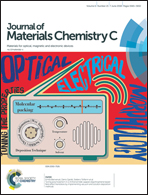Gate-tunable interfacial properties of in-plane ML MX2 1T′–2H heterojunctions†
Abstract
The two-dimensional (2D) transition-metal dichalcogenides (TMDs) field effect transistor (FET) with in-plane heterojunction contacts between the semiconducting 2H phase (as channel) and the metallic 1T or semi-metallic 1T′ phase (as electrode) has received much recent attention because it has significantly reduced contact resistance and enhanced gate tunability and thus improved device performance. However, the underlying mechanism of its good conductivity remains open. We systematically explore for the first time the contact properties of the monolayer (ML) 2H MX2 (MoS2, WS2, MoSe2, WSe2, MoTe2) FET with their 1T′ phase as electrode by using ab initio quantum transport simulations. We find that the metal induced gap states (MIGS) at the interface penetrate the Schottky barrier and bridge the electrodes and the conduction/valence band of the channel, thereby forming a lower and tunable effective Schottky barrier height (ESBH) and causing an equivalent Ohmic contact under the appropriate gate voltage. Our study provides a new insight into the observed reduced contact resistance with the 1T′ phase as electrode and is instructive for further experiment.



 Please wait while we load your content...
Please wait while we load your content...